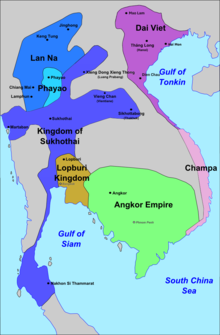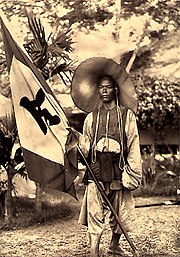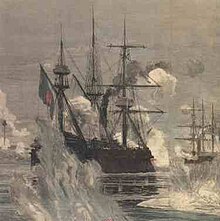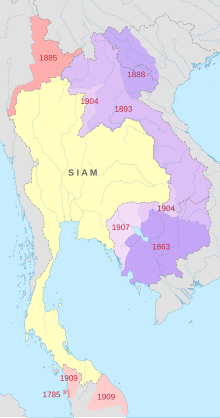History of Laos
The subsequent Austroasiatic and Austronesian marine migration waves affected landlocked Laos only marginally, and direct Chinese and Indian cultural contact had a greater impact on the country.[7] These immigrants might have, to a certain extent, merged and reproduced with members of the archaic population of Homo erectus, as the 2009 fossil discoveries in the Tam Pa Ling Cave suggest.[9] An early tradition is discernible in the Hoabinhian, the name given to an industry and cultural continuity of stone tools and flaked cobble artifacts that appears around 10,000 BP in caves and rock shelters first described in Hòa Bình, Vietnam and later also in Laos.[13] Earliest known copper and bronze production in Southeast Asia has been confirmed at the site of Ban Chiang in modern north-east Thailand and among the Phung Nguyen culture of northern Vietnam since around 2000 BCE.The jars, stone sarcophagi dating from the early Iron Age (500 BCE to 800 CE), contained evidence of human remains, burial goods, and ceramics.[24] The Chinese Han dynasty chronicles of the southern military campaigns provide the first written accounts of Tai–Kadai speaking peoples who inhabited the areas of modern Yunnan China and Guangxi.James R. Chamberlain (2016) proposes that Tai-Kadai (Kra-Dai) language family was formed as early as the 12th century BCE in the middle Yangtze basin, coinciding roughly with the establishment of the Chu and the beginning of the Zhou dynasty.[25] The Tai peoples, from Guangxi and northern Vietnam began moving south—and[clarification needed] westwards in the first millennium CE, eventually spreading across the whole of mainland Southeast Asia.[26] Based on layers of Chinese loanwords in proto-Southwestern Tai and other historical evidence, Pittayawat Pittayaporn (2014) proposes that the southwestward migration of Tai-speaking tribes from the modern Guangxi and northern Vietnam to the mainland of Southeast Asia must have taken place sometime between the 8th and 10th centuries.The first half of the sixteenth century allowed for the power, prestige and cultural influence of the kingdom to be restored under a series of strong kings (see Souvanna Balang, Vixun, Photisarath).Setthathirath moved the capital of Lan Xang from Luang Prabang to Vientiane in 1560, to better defend against the threat of Burma and to more ably administer the central and southern provinces.In the 1640s the first European explorers to leave a detailed account of the kingdom arrived looking to establish trade and secure Christian converts, both were ultimately largely unsuccessful.King Sourigna Vongsa was known to uphold the law stricty, an episode exemplified this when he did not intervene when his son (and successor) was sentenced to death when it was found that he seduced the wife of a senior court official.Taksin also demanded that the ruling elites of the Lao kingdoms and their royal families pledge vassalage to Siam in order to retain their regional autonomy in accordance with the Mandala model.In 1778, only Nakhon Ratchasima was a tributary of Siam, yet by the end of the reign of Rama I Sisaket, Ubon, Roi Et, Yasothon, Khon Khaen, and Kalasin paid tribute directly to Bangkok.Nanthasen was allowed to return to Vientiane with the Phra Bang, the palladium of Lan Xang, the Emerald Buddha remained in Bangkok and became an important symbol to the Lao of their captivity.The history of forced population transfers, corvee labor projects, loss of national symbols and prestige (most notably the Emerald Buddha) formed the backdrop to specific actions taken by Rama III to directly annex the Isan region.When Anouvong arrived for the funerary services, he made several requests of the king Rama III which were dismissed including the return of his sister who had been captured in 1779, and Lao families which had been relocated to Saraburi near Bangkok.Rama III ordered Chao Bodin to return and level the city of Vientiane, and forcibly move the entire population of the former Lao capital to the Isan region.Artisans and members of the court were forcibly moved to Saraburi near Bangkok, and several thousand farmers and peasant who were transported throughout Siam to Phetchaburi, Ratchaburi, and Nakhon Chaisi in the southwest and to Prachinburi and Chanthaburi in the southeast.The population transfers and slave raids ameliorated toward the end of the nineteenth century when European observers and anti-slavery groups made their presence increasingly difficult for the Bangkok elite.To counter British control in Burma and growing influence in Siam, that same year France sought to establish representation in Luang Prabang, and dispatched Auguste Pavie to secure French interests.The incident won the gratitude of the king, provided an opportunity for France to gain control of the Sipsong Chu Thai as part of Tonkin in French Indochina, and demonstrated the weakness of the Siamese in Laos.France and Siam would position troops to deny each other's interests, resulting in a Siamese siege of Khong Island in the south and a series of attacks on French garrisons in the north.The French concentrated on the development of infrastructure, the abolition of slavery and indentured servitude (although corvee labor was still in effect), trade including opium production, and most importantly the collection of taxes.[36] As late as 1945, the French even drew up an ambitious plan to move massive Vietnamese population to three key areas, i.e. the Vientiane Plain, Savannakhet region, Bolaven Plateau, which was only discarded by Japanese invasion of Indochina.It was not until the movement spread to the Khorat Plateau and threatened to become an international incident involving Siam that several French columns of the Garde Indigene converged to put down the rebellion.French interest in indigenous history served a dual purpose in Laos it reinforced the image of the colonial mission as protection against Siamese domination, and was also a legitimate route for scholarship.Charles Rochet the French Director of Public Education in Vientiane, and Lao intellectuals led by Nyuy Aphai and Katay Don Sasorith began the Movement for National Renovation.By 1954 the defeat at Dien Bien Phu brought eight years of fighting with the Vietminh, during the First Indochinese War, to an end and France abandoned all claims to the colonies of Indochina.












Muang SuaLan XangKingdom of VientianeKingdom of Luang PhrabangMuang PhuanKingdom of ChampasakLao rebellionHaw warsFranco-Siamese crisisFrench Protectorate of LaosFranco-Thai WarJapanese puppet stateFree Lao Movement (Lao Issara)Kingdom of LaosLaotian Civil WarNorth Vietnamese invasion of LaosAnti-Communist InsurgencyHistory of IsanIndochinaLower PaleolithicAustralo-MelanesiansHoabinhianAustroasiaticAustronesianLuang PrabangVientianeChampasakSiameseFrench Colonial Empireunexploded ordnanceÉcole française d'Extrême-OrientLao Civil WarMekong RiverAnatomically modern humanHomo erectusTam Pa Ling CaveAustro-AsiaticLao TheungKatangNeolithicBan ChiangPhung Nguyen culturePlain of JarsXiangkhouangXieng Khouang PlateaumegalithicUNESCO World Heritage SitesarcophagiIron AgeIndosphereGreater Indiahonorific titlesHinduismBuddhismtraditional Indian clothingIndian diasporaKingdom of FunanIndianised kingdomWat PhuChampaCham peopleChenlaSambor Prei KukTang dynastyMataramMon peopleChao Phraya RiverDvaravati kingdomsHaripunjayaLamphunTha KhekTherevada BuddhismOld Yue languageTai peoplesthe LaoKingdom of NanzhaoHan dynastysouthern military campaignsTai–KadaiYunnanGuangxiZhou dynastypresent-day Zhejiangstate of YueLuo YueNorthern TailoanwordsSouthwestern TaiMai Thúc LoanNanyueGuangdongpresent-day GuangxiNanchaoA NongNong ZhigaoNanningGuangzhoukingdom of LannaSukhothai KingdomKhmer EmpireRam Khamhaengkingdom of Lan XangAyutthaya kingdomLiterature of LaosKhun BoromFa NgumSipsong Chu TaiSipsong PannaKhorat PlateauStung TrengDai VietPhotisarathAyutthayaBurmeseSetthathirathToungoo dynastyBayinnaungSourigna VongsaKingdom of Luang PrabangLe Duy HiepKingdom of AyutthayaNokasadXe Bang RiverLao–Siamese War (1778–1779)Thonburi KingdomRattanakosin Kingdom


